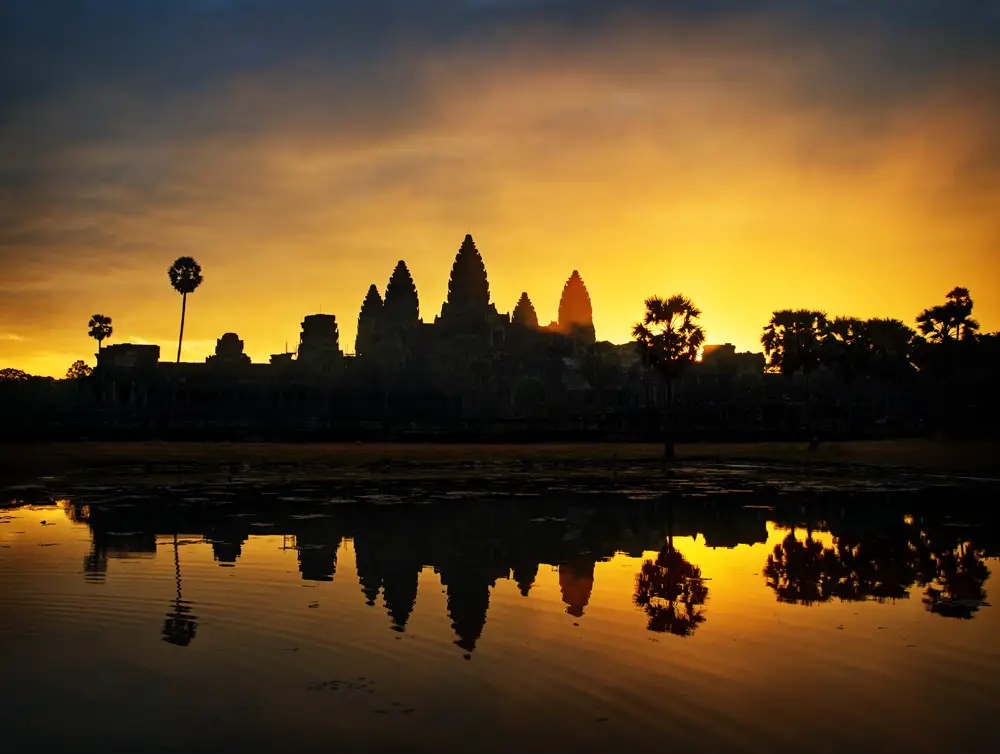This site is part of various affiliate programs. Links may give us a small compensation for any purchases you make, at no additional cost to you. Please read the disclaimer policy for full details.
If you are in a rush and don’t have time to read the article, then:
- the overall best lens for the Canon 6D and Canon 6D Mark II is the Canon EF 24–105mm f/4L IS II USM Lens
- the best wide angle lens is the Canon EF 16-35mm f/4L IS USM Lens
- the best telephoto 6D lens is the Canon EF 70-200mm f/2.8L IS III USM
Whether you are looking for the best lens for Canon 6D or the best lens for Canon 6D Mark II, then you have come to the right place. This article covers reviews of the top Canon EOS 6D lenses, from the best wide angle lenses, to the best telephoto zoom lenses, via the best portrait and all around lenses.
Every lens that I have reviewed here are Canon 6D compatible lenses, from my own experience of using the Canon 6D over several years with many different lenses. This was my second full frame Canon camera, following the Canon 5D, and I even used the 6D and some of the lenses below professionally for several years. Take a look below for the overall best lens, or find the type of lens you are interested in below.
Table of Contents
- 1. Best Lens Canon 6D
- 2. Canon 6D Lens Compatibility
- 3. Best Wide Angle Lens for Canon 6D
- 4. Best Zoom Lens for Canon 6D
- 5. Best Portrait Lens for Canon 6D
- 6. Best Telephoto Lens for Canon 6D
- 7. Best Macro Lens for Canon 6D
- 8. Canon 6D Lenses Quick Comparison
- 9. Common Questions about Canon 6D Lenses
1. Best Lens Canon 6D
Best Lens for Canon 6D
-
- Long Range of Focal Lengths
- Image Stabilization
- Relatively Cheap
- Sharp Images
- All Round Zoom Lens
- Some Distortion in the Corners
The Canon 24–105mm f/4L lens is often included as a kit lens, which should give some indication that this is the best lens for Canon 6D and the best lens for Canon 6D Mark II. I got this lens with my 6D, and it has spent a considerable amount of time as my primary lens, thanks to its wide ranging zoom, image stabilization, and overall very good image quality.
I would consider the 24-105mm f4 lens to be the best all in one lens for Canon, from landscapes to portraits and even minor telephoto work. It’s also just about possible to use this lens for astrophotography.
This lens may not have the widest maximum aperture, but the attractive price more than makes up for it, and the excellent image stabilization means this is not a problem in practice.
There is some distortion in the corners of frame when used at the widest possible focal length, which is to be expected with a zoom lens that covers such a wide range of focal lengths. I don’t find this to be a problem in everyday use, but if you are a pixel peeper, you may want to consider Canon’s prime lenses.
Although some of the more specialized lenses covered below are better for specific situations, the 24-105mm f4 lens remains the best all in one lens for Canon, and therefore in my opinion, the overall best lens for the Canon 6D.
I have used this lens for a lot of my landscape and cityscape photography, such as the photos below, and have never run into any quality issues.


2. Canon 6D Lens Compatibility
If you are new to photography, it’s worth quickly pointing out the differences that determine Canon 6D lens compatibility. The Canon 6D lens mount is EF. This means that it takes full frame lenses, and will not properly work with lenses denoted EF-S (crop sensor cameras), or any other lens mounting. You should look for EF in the title of the lens, if it is Canon manufactured, to be sure it is the correct mount.
You do not need to exclusively buy Canon lenses though, as many other manufacturers make lenses for the EF mount, but all use their own terminology to denote whether a lens is full frame compatible or not. To use a third party lens with your Canon 6D or Canon 6D Mark II, you need to confirm that it uses the EF mount and is a full frame lens.
What to Look for in a Lens for the Canon 6D
When starting to build your collection of lenses, there are a number of points you should keep in mind, detailed below in order of importance. Feel free to copy this list if you need to do any future research.
- Overall value for money: This should be your primary decision point, and is largely based on what you personally consider value for money. Consider asking yourself questions like: how often will I use this lens?; is the lens affordable to me?; do I want this because it is a ‘shiny new thing’?
- What type of photography are you interested in? If you are into landscapes, you will likely want to focus on wide angle lenses, and a wide maximum aperture is unlikely to matter to you, as you will often be shooting at around f/11. If you are a wildlife photographer, then you will want a zoom telephoto lens, with the widest aperture possible, often f/2.8. For general walk around use, then a mid-range zoom with image stabilization will suit you.
- Maximum aperture (lens speed): The larger the maximum aperture of a lens (ie. the smaller the number so that f/2.8 is a larger aperture than f/4), then the heavier and larger the lens will be for a given focal length, and also more expensive. Whether the speed of the lens matters to you or not will depend on what kind of photography you are interested in, as above.
- Is the aperture constant through the zoom range? Cheaper zoom lens often have a narrower maximum aperture the further out they are zoomed. This will be denoted in the lens title as something like ‘f/3-5.6’. This is not necessarily a problem if you don’t expect to be shooting with the lens wide open, but the apertures are often very narrow at the long end of the lens, making this type of lens unsuited for wildlife photography.
- Prime vs Zoom: Prime lenses offer better image quality, at the expense of a fixed focal length, as well as generally having much wider maximum apertures. Because of the wide apertures, they are often about the same size and weight as zoom lenses, and also come in at about the same price. Whether you choose the better image quality primes, or more convenient zooms will depend on how you intend to use the lens. Personally, I find zoom lenses are ideal for almost everything, with the exception of specific styles of photography, such as astrophotography.
- Image stabilization: This is really only relevant for zoom lenses, or those primes with long focal lengths. A general rule of thumb is that to avoid camera shake, you should shoot at a shutter speed of 1/focal length. This means that wide angle lenses can be shot hand-held even in relative darkness and still not exhibit much, if any, camera shake. Telephoto lenses need fast shutter speeds though, meaning you must often turn your ISO up. Image stabilization helps avoid this, by letting you shoot at a slower shutter speed which lets more light into your sensor, and means you can turn down the ISO. Having image stabilization does come at a price and weight premium though.
- Weather sealing & build quality: Lenses like Canon’s L series have top quality build and weather sealing, with rubber gaskets around the lens mount and focus rings that stop moisture ingress. Cheaper lenses do not have this, so you must take more care when using them in inclement weather. Think about the environment you will be using your lenses in to determine whether this matters to you.
- Weight: If you are only using your lens on a tripod, weight may not be an issue, but if you are carrying it around all day, whether on you camera or in a camera bag, even lighter lenses can suddenly feel very heavy.
- Future camera compatibility: All of these lenses reviewed here are the Canon EF mount and suitable for full frame cameras, and should be suitable for any future Canon cameras, but if you look elsewhere for lenses, make sure you check for Canon full frame compatibility.
3. Best Wide Angle Lens for Canon 6D
Best Wide Lens for Canon 6D
-
- Fantastic Image Quality
- Image Stabilization
- Canon L Series Build Quality & Weather Sealing
- Best Ultra Wide Angle Lens for Canon 6D
- Some Distortion in the Corners at f/4
The Canon EF 16-35mm f/4L IS USM Lens is the cheaper alternative to the Canon EF 16-35mm f/2.8L Lens, and ss a pair, these are the best wide angle lenses for Canon 6D that you will find. The first lens, that is recommended here, has image stabilization (IS), but only a maximum aperture of f4, while the second lens does not have IS, but does have a wider max aperture of f2.8.
Personally, I have used an f/4 Canon wide angle lens for some years, and have never experienced any problems with not having a super a wide aperture. For most landscape uses (which is what you are most likely to want a wide angle lens for) you will be stopping down the lens to f/8 or f/11 to hit the lens sweet spot for sharpness and depth of field.
The addition of IS means that even if you are shooting the lens wide open, you can use about the same shutter speed and ISO as with the f/2.8 lens shot wide open, so it is still suitable for hand-held photography on both the Canon 6D and Canon 6D Mark II.
The only area where the f2.8 lens excels over the f4 lens, is in astrophotography, where you need the extra wide aperture to properly photograph the stars or Northern Lights.
Canon EF 17-40mm f/4L USM Ultra Wide Angle Zoom Lens
Best Lens for Canon 6D Landscape

- Pros:
- Very good image quality & sharpness
- Useful zoom range
- The cheapest ultra wide angle Canon lens
- Cons:
- Soft in the corners at f/4
- No image stabilization
The Canon EF 17-40mm f/4L lens is probably the best landscape lens for Canon, thanks to its very good image quality and sharpness, which improves to excellent as you stop the lens down to f/11, and its inexpensive price.
This was my first wide angle lens for the Canon 6D, and if your budget does not stretch to the 16-35mm lens, this will be the best wide angle lens for Canon 6D Mark II, also.
You have some trade-offs for the lower price, such as no image stabilization and only a maximum aperture of f/4, but I found neither of these to be a problem in practice. The lens is relatively small and light, when compared with f/2.8 wide angle lenses, and the weather sealing and build quality is excellent, as would be expected from a Canon L series lens.
The focal length of this lens, from 17mm to 40mm, gives you a choice of use cases, from landscape to almost a portrait focal length, although the f/4 max aperture means the lens is not suited to portraits.
If you are on a strict budget for your Canon 6D or Canon 6D Mark II, this makes a very good case to be the best wide angle lens for Canon 6D Mark II.
Sigma 20mm f/1.4 Art Lens
Best Lens for Night Photography Canon

- Pros:
- Outstanding sharpness across the frame
- Very wide f/1.4 max aperture
- Minimal chromatic aberration and distortion
- Reasonably priced compared with Canon manufactured lenses
- Cons:
- Fixed focal length
- No image stabilization
The Sigma 20mm f/1.4 Art Lens is the finest astrophotography or night lens that you can buy, with superb sharpness across the lens and almost no coma or distortion, combined with a very wide maximum aperture of f1.4.
As this is a fixed focal length lens, you are more limited in the kinds of situations that you can use this lens. It’s mostly suited for landscape photography, but is particularly strong for night photography and star photography, thanks to the wide f/1.4 max aperture.
The advantage of having a fixed focal length is the superior image quality, with minimal distortion, and excellent sharpness throughout the frame, even in the corners. The lineup of Sigma Art lenses are now really challenging Canon as the best lenses for Canon 6D, particularly as they are often cheaper than the comparable Canon lenses.
4. Best Zoom Lens for Canon 6D
Best Zoom Lens for Canon 6D
-
- Outstanding Image Quality
- Sharp Images from Corner to Corner
- Relatively Long Zoom Range
- Super Fast & Quiet Autofcous
- No Image Stabilization
The Canon EF 24-70mm f/2.8L II USM Lens is not one that I would necessarily recommend for a first lens for your Canon 6D due to its price, but it is almost certainly one of the best zoom lenses that you can buy. The image quality is outstanding with minimal distortion, even when shooting wide open at the maximum aperture of f/2.8.
This lens has a relatively long zoom range, from 24mm to 70mm, which lets you use it for some wide angle landscape photography, as well as for portraits and minor telephoto work. It manages to maintain excellent quality for all three uses, essentially giving you multiple prime lenses contained within the one zoom lens.
The lens is very sharp, corner to corner, particularly when stopped down to f/11, and the auto focus is both very quiet and fast. Although this lens may seem expensive, the fact that it is able to replace several prime lenses and can stay on your camera long term, without you having to change to another lens, makes it much better value for money.
Canon EF 24-105mm f/3.5-5.6 IS STM Lens
Best Travel Lens for Canon 6D

- Pros:
- Good image quality
- Long zoom range
- Very good value for money as a used lens
- Image stabilization
- Cons:
- Narrow max aperture
- Lower build quality
- Slower auto focus
- Less sharp
The Canon EF 24-105mm f/3.5-5.6 lens is a budget, non-L series lens from Canon that still takes very good photos on the Canon 6D and Canon 6D Mark II. You will not get the image quality of the more expensive zoom lens above, but it is more than good enough for most people.
The relatively narrow max aperture is offset by the included image stabilization, so this lens can still be used as a walk around travel lens, although the slightly slower auto focus, the lower build quality which does not include weather sealing, and the less sharp optics means that it is not perfect. It is much lighter and smaller than the comparable L series lenses though.
For the zoom range of this lens, at 24mm to 105mm, and the fact that it is available for under $350 as a used lens, makes this probably the best all round budget lens for the Canon 6D.
5. Best Portrait Lens for Canon 6D
Best 50mm Lens for Canon 6D
-
- Best 50mm Canon Lens for Everyday Use
- f/1.8 Aperture is still wider than most kit lenses
- Closer Max Focusing Distance than f/1.8 lens
- Lightest Canon 50mm Lens
- Cheapest 50mm Lens
- No Distance Scale on focusing ring
The Canon EF 50mm F1.8 STM lens is of a lower overall quality than the Canon 50mm f1.4 lens, but nonetheless offers exceptional value for money for the Canon 6D – this is the only Canon 50mm lens available for around $100 as a used lens, and has been known as the ‘nifty fifty’ thanks to this low price and its performance.
The depth of field and low light capabilities are more than enough for everyday use, including some portraits. If you are not selling photos professionally, or you are on a strict budget, this lens will be good enough for you in most situations.
If this is your first 50mm lens, then you will see a huge difference from your other lenses, even buying the 1.8 aperture version, and unless you are a professional, I would highly recommend this lens for the cost saving over the 1.4 50mm lens.
The downsides to this lens is the slower, more clunky autofocus, that can sometimes really ‘hunt’ to pick up focus. This is partially due to the motor, and partially because of the less wide aperture preventing as much light from getting to the autofocus system in your camera. This also means that the viewfinder will be darker.
Canon 40mm f/2.8 Lens
Best Lens for Street Photography

- Pros:
- Excellent image quality
- Very sharp
- Very good autofocus
- Relatively cheap
- Cons:
- Front element is unprotected, so you get lens flare in bright environments
- No lens hood provided
- Less good for portraits due to maximum f/2.8 aperture
The Canon 40mm f 2.8 STM makes an excellent street photography lens due to its high quality optics, very small size and near-silent autofocus. The Canon 40mm lens price is currently around 50% more than the comparable Canon 50mm 1.8 lens, but as long as you are not primarily interested in shooting portraits and still life pictures, the 40mm pancake lens is the better option. This is particularly true if you are using a crop sensor camera (APS-C).
On the downside, the 40mm lens can have a problem with lens flare, due to the front element being completely unprotected. With the relatively cheap price, this is no lens hood provided. You can buy a Canon 40mm lens hood for a few dollars, and this is highly recommended if you are going to be regularly shooting outside.
6. Best Telephoto Lens for Canon 6D
Best Telephoto Lens for Canon 6D
-
- Excellent Image Quality
- Image Stabilization
- Wide f/2.8 Aperture Throughout Zoom Range
- Very Fast Auto Focus
- Expensive
The Canon EF 70-200mm f/2.8L Lens has the complete package for a telephoto zoom lens, with an unusually large max aperture across the entire range of focal lengths. As with other Canon L series lenses, you know that you are getting fantastic build quality with weather sealing, and you know the image quality and sharpness will be second to none.
Bear in mind that the f2.8 model is both heavier and a few hundred dollars more expensive than the f4 version of this lens.If you don’t need the extra low light capabilities that this lens gives you, then the Canon EF 70-200mm f/4L IS II Lens may be a better choice. Other than aperture, size, weight and price, they are identical.
Canon EF 70-200mm f/4L USM
Best Budget Telephoto Zoom Lens for Canon 6D

- Pros:
- Excellent Image Quality & Sharpness
- Fast autofocus
- Relatively Light
- Cheapest Canon L Series Zoom Lens
- Cons:
- No image stabilization
- Max aperture only f/4
The Canon EF 70-200mm f/4L Lens is the cheaper alternative to the zoom lens above. This fits in the same focal range, but does not have image stabilization, and the max aperture is f4.
On the plus side, this lens is significantly lighter than the f2.8 IS version, and does not sacrifice image quality. Remember that without image stabilization, you will have to shoot at relatively high shutter speeds (approximately 1/focal length is recommended to avoid camera shake), which means you will likely have to turn your ISO up or use the lens on a tripod. The Canon 6D and Canon 6D Mark II both have excellent high ISO performance though, so this should not be a problem.
If you are on a tighter budget, this is the ideal telephoto zoom lens that you can buy for the Canon 6D.
7. Best Macro Lens for Canon 6D
Best Macro Lens for Canon 6D
-
- 100mm Focal Length and f2.8 Maximum Aperture
- Image Stabilization
- Closest Focusing Distance 0.99′ (0.3m)
- Maximum Magnification 1x
- Canon’s Most Popular Macro Lens
This macro lens for Canon 6D has outstanding image quality combined with a wide maximum aperture of f2.8 and image stabilization, making it incredibly easy to take shallow depth of field macro photos, without blur from camera shake.
The 1x max magnification means that objects can be projected life-size onto your camera’s sensor, meaning no cropping or enlarging of your photos should be needed. This is also the best macro lens for Canon 6D Mark II.
8. Canon 6D Lenses Quick Comparison
Below is a quick comparison table of all the Canon 6D Lenses we have looked at so far.
| Lens | Average User Rating | Type | Image Stabilization | Max Aperture | Cost | Check Price |
|---|---|---|---|---|---|---|
Canon EF 16-35mm f/4L IS USM Lens
 |
4.7 / 5 | Wide Angle | Yes | f/4 | $$$$ | |
Canon EF 17-40mm f/4L USM Lens
 |
4.7 / 5 | Wide Angle | No | f/4 | $$$ | |
Sigma 20mm f/1.4 Art Lens
 |
4.4 / 5 | Wide Angle | No | f/1.4 | $$$ | |
Canon EF 24–105mm f/4L IS II USM Lens
 |
4.4 / 5 | All Round Zoom | Yes | f/4 | $$$$ | |
Canon EF 24-70mm f/2.8L II USM Lens
 |
4.9 / 5 | All Round Zoom | No | f/2.8 | $$$$$ | |
Canon EF 24-105mm f/3.5-5.6 IS STM Lens
 |
4.9 / 5 | All Round Zoom | Yes | f/3.5 – f/5.6 | $$ | |
Canon EF 50mm f/1.8 STM Lens
 |
4.8 / 5 | Portrait Lens | No | f/1.8 | $ | |
Canon 40mm f/2.8 Lens
 |
4.7 / 5 | Portrait / Street Lens | No | f/2.8 | $ | |
Canon EF 70-200mm f/2.8L IS III USM
 |
4.8 / 5 | Telephoto Zoom | Yes | f/2.8 | $$$$$ | |
Canon EF 70-200mm f/4L USM
 |
4.7 / 5 | Telephoto Zoom | No | f/4 | $$ | |
Canon EF 100mm f/2.8L IS USM Macro Lens
 |
4.9 / 5 | Macro | Yes | f/2.8 | $$$$ |
9. Common Questions about Canon 6D Lenses
What are the Best Cheap Lenses for Canon?
The best cheap lenses for canon are the Canon 50mm f/1.8 for portrait and street photography, the Canon 17-40mm f/4 for wide angle photos and landscapes, and the Canon 70-200mm f/4 lens for telephoto shots.
What are the best lenses for travel photography for the Canon 6D?
The best travel lenses for the Canon 6D are zoom lenses that have a relatively large focal length range, but are still compact and light enough to carry around with you all day. My preferred travel photography lens for the Canon 6D is the Canon EF 24–105mm f/4L IS II USM Lens for these reasons. See the full review above.
What is a good moderately priced general lens for Canon 6D?
There are plenty of relatively cheap lenses for the 6D. As a good starter lens, then the Canon EF 24-105mm f/3.5-5.6 IS STM Lens is hard to beat, as it has image stabilization, a long zoom range, very good image quality, and is available for under $350 used.
What lenses are compatible with a Canon EOS 6D?
The Canon 6D is a full frame camera, so will only work properly with EF mount lenses from Canon, and third party lenses that mimic this lens mount.












Leave a Reply